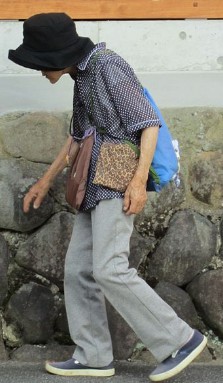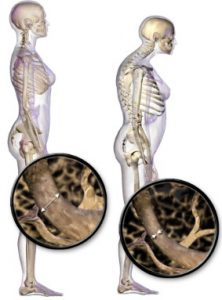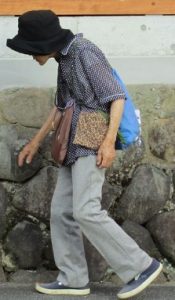Osteoporosis generally impacts people as they age, although it can impact almost anyone. The condition causes a person’s bones to become brittle and weak. The density of the bone decreases and a person’s bones become susceptible to breaks and fractures. The bones are comprised of calcium, protein, and collagen. When any of these are compromised, the bones become porous and weak. When osteoporosis is advanced, the bones can become so weak and porous that they resemble a sponge and can be easily compressed. Osteoporosis typically affects the hips, spine, wrists, and ribs, although fractures can occur in almost any of the body’s bones.
Can Osteoporosis Cause Neck and Back Pain?
When someone has osteoporosis, their bones are weaker than normal. This means that when they place pressure on the joints or bones, it can result in fractures or swelling in the joints. People with osteoporosis are at a higher risk of neck or back pain because their bones are weaker and can easily fracture or break under any type of pressure.
Individuals in certain careers are at a higher risk of problems from osteoporosis. These include surgeons, computer professionals, over-the-road truck drivers, bus drivers and conductors, chefs, and tailors. Generally, anyone who sits or stands for prolonged periods of time are susceptible to injuries due to osteoporosis.
- See Best Office Standing Desks for Back and Neck Pain with Buyer’s Guide
- See Best Ergonomic Office Chairs for Back and Neck Pain with Buyer’s Guide
- See Best Gaming Chairs for Back Pain with Buyer’s Guide
What Causes Osteoporosis?
There are certain factors and characteristics that can increase a person’s chances of developing osteoporosis. These include:
- Asian or Caucasian
- Being female
- Lack of exercise
- A family history of osteoporosis
- Small or thin body frame
- Poor nutrition
- Excessive or long-term smoking
- Not enough calcium in the diet
- Malabsorption of calcium
- Low testosterone levels in men, also called hypogonadism
- Low estrogen levels in women. This can be due to menopause or a hysterectomy.
- Chemotherapy which can negatively impact the ovaries and force a woman into early menopause
- Hyperthyroidism
- Chronic inflammation as a result of certain diseases including liver disease or rheumatoid arthritis
- Vitamin D deficiency
- Inherited genetic disorders affecting the connective tissues
- Certain medications
What are the Symptoms of Osteoporosis?
A person can have osteoporosis and not present symptoms for many years. Most aren’t diagnosed with this disease until they experience a bone fracture or break. It is also possible for a person to fracture a bone but not realize it, again because there are no symptoms. The most common symptom of osteoporosis is a painful fracture. A person will typically notice pain in the area of the fracture. Men and women experience similar symptoms when they have osteoporosis.
The most common symptoms of osteoporosis include:
- Fractures caused by a strong cough or sneeze
- Fractures due to a simple movement or a mild fall
- Stooped posture or a curved back as a result of vertebrae compression
- Pain in the back or neck as a result of spinal compression or a spinal fracture
If a person experiences a spinal fracture, they may feel intense band-like pain radiating from their back and along the sides of their body. When a person has osteoporosis, they may experience small spinal fractures over a number of years. This can lead to chronic pain in the lower back, curving of the spine, or a loss of height. When the vertebrae collapse, the individual’s spine will begin to curve and they will develop what is known as a “dowager hump”.
People with osteoporosis may experience significant discomfort. When they experience a fracture, they should seek immediate medical attention.
Treatment and Prevention of Osteoporosis
Most healthcare providers prescribe an osteoporosis treatment plan designed to help prevent bone fractures. They prescribe treatments and medications to prevent bone loss and increase bone strength and density. Early detection is important and can decrease the risk of fractures substantially, but the disease cannot be cured. It is also difficult to increase bone density and replace lost bone due to osteoporosis. The most commonly prescribed methods of treatment for osteoporosis include:
– Medications formulated to increase bone strength and density and stop bone loss. These include risedronate (Actonel), alendronate (Fosamax), ibandronate (Boniva), raloxifene (Evista), calcitonin (Calcimar), denosumab (Prolia) and zoledronate (Reclast). A healthcare provider may also prescribe medications to increase bone formation.
– Lifestyle changes which include adding calcium to the diet, quitting smoking and excessive drinking, and exercising regularly. Exercise should include weight training.
– Physical relief and pain treatment using non-medication treatments. These may include braces and supports, heat and ice, and acupuncture, massage therapy and acupressure. These types of treatments can help relieve the pain of fractures or stiff muscles. Using a back brace or some type of support provides a patient with more mobility without pain and allows the spine to heal. It is recommended to use a back brace only while the spine is healing since the muscles of the back may become weaker with prolonged back brace support. Acupuncture treatments and massage therapy help ease the tension and pain caused by osteoporosis fractures and injuries.
Diagnosing and treating osteoporosis includes certain medications, lifestyle changes, and non-medication treatments. Early diagnosis and treatment can help improve bone strength and prevent additional injuries.






